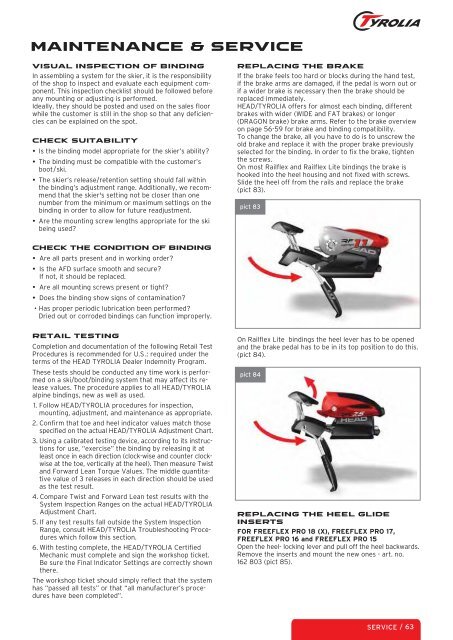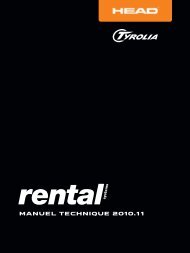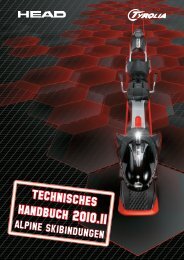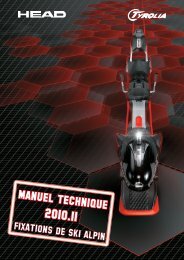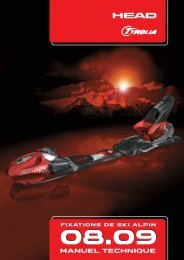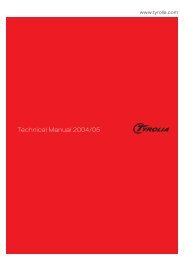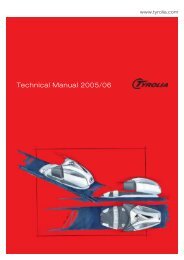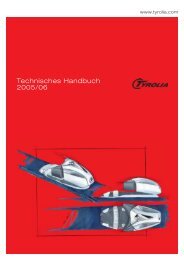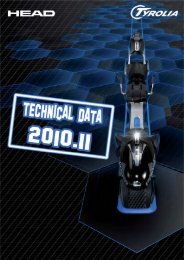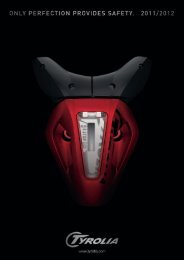Create successful ePaper yourself
Turn your PDF publications into a flip-book with our unique Google optimized e-Paper software.
MAINTENANCE & SERVICE<br />
VISUAL INSPECTION OF BINDING<br />
In assembling a system for the skier, it is the responsibility<br />
of the shop to inspect and evaluate each equipment component.<br />
This inspection checklist should be followed before<br />
any mounting or adjusting is performed.<br />
Ideally, they should be posted and used on the sales floor<br />
while the customer is still in the shop so that any deficiencies<br />
can be explained on the spot.<br />
CHECK SUITABILITY<br />
• Is the binding model appropriate for the skier’s ability?<br />
• The binding must be compatible with the customer’s<br />
boot/ski.<br />
• The skier’s release/retention setting should fall within<br />
the binding’s adjustment range. Additionally, we recommend<br />
that the skier's setting not be closer than one<br />
number from the minimum or maximum settings on the<br />
binding in order to allow for future readjustment.<br />
• Are the mounting screw lengths appropriate for the ski<br />
being used?<br />
CHECK THE CONDITION OF BINDING<br />
• Are all parts present and in working order?<br />
• Is the AFD surface smooth and secure?<br />
If not, it should be replaced.<br />
• Are all mounting screws present or tight?<br />
• Does the binding show signs of contamination?<br />
• Has proper periodic lubrication been performed?<br />
Dried out or corroded bindings can function improperly.<br />
RETAIL TESTING<br />
Completion and documentation of the following Retail Test<br />
Procedures is recommended for U.S .: required under the<br />
terms of the HEAD TYROLIA Dealer Indemnity Program.<br />
These tests should be conducted any time work is performed<br />
on a ski/boot/binding system that may affect its release<br />
values. The procedure applies to all HEAD/TYROLIA<br />
alpine bindings, new as well as used.<br />
1. Follow HEAD/TYROLIA procedures for inspection,<br />
mounting, adjustment, and maintenance as appropriate.<br />
2. Confirm that toe and heel indicator values match those<br />
specified on the actual HEAD/TYROLIA Adjustment Chart.<br />
3. Using a calibrated testing device, according to its instructions<br />
for use, “exercise” the binding by releasing it at<br />
least once in each direction (clock-wise and counter clockwise<br />
at the toe, vertically at the heel). Then measure Twist<br />
and Forward Lean Torque Values. The middle quantitative<br />
value of 3 releases in each direction should be used<br />
as the test result.<br />
4. Compare Twist and Forward Lean test results with the<br />
System Inspection Ranges on the actual HEAD/TYROLIA<br />
Adjustment Chart.<br />
5. If any test results fall outside the System Inspection<br />
Range, consult HEAD/TYROLIA Troubleshooting Procedures<br />
which follow this section.<br />
6. With testing complete, the HEAD/TYROLIA Certified<br />
Mechanic must complete and sign the workshop ticket.<br />
Be sure the Final Indicator Settings are correctly shown<br />
there.<br />
The workshop ticket should simply reflect that the system<br />
has “passed all tests” or that “all manufacturer’s procedures<br />
have been completed”.<br />
REPLACING THE BRAKE<br />
If the brake feels too hard or blocks during the hand test,<br />
if the brake arms are damaged, if the pedal is worn out or<br />
if a wider brake is necessary then the brake should be<br />
replaced immediately.<br />
HEAD/TYROLIA offers for almost each binding, different<br />
brakes with wider (WIDE and FAT brakes) or longer<br />
(DRAGON brake) brake arms. Refer to the brake overview<br />
on page 56-59 for brake and binding compatibility.<br />
To change the brake, all you have to do is to unscrew the<br />
old brake and replace it with the proper brake previously<br />
selected for the binding. In order to fix the brake, tighten<br />
the screws.<br />
On most Railflex and Railflex Lite bindings the brake is<br />
hooked into the heel housing and not fixed with screws.<br />
Slide the heel off from the rails and replace the brake<br />
(pict 83).<br />
pict 83<br />
On Railflex Lite bindings the heel lever has to be opened<br />
and the brake pedal has to be in its top position to do this.<br />
(pict 84).<br />
pict 84<br />
REPLACING THE HEEL GLIDE<br />
INSERTS<br />
FOR FREEFLEX PRO 18 (X), FREEFLEX PRO 17,<br />
FREEFLEX PRO 16 and FREEFLEX PRO 15<br />
Open the heel- locking lever and pull off the heel backwards.<br />
Remove the inserts and mount the new ones - art. no.<br />
162 803 (pict 85).<br />
SERVICE / 63


